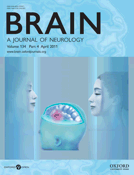-
PDF
- Split View
-
Views
-
Cite
Cite
Cecilia Marelli, Patrizia Amati-Bonneau, Pascal Reynier, Valérie Layet, Antoine Layet, Giovanni Stevanin, Etienne Brissaud, Dominique Bonneau, Alexandra Durr, Alexis Brice, Heterozygous OPA1 mutations in Behr syndrome, Brain, Volume 134, Issue 4, April 2011, Page e169, https://doi.org/10.1093/brain/awq306
Close - Share Icon Share
Sir, We read with interest the paper by Yu-Wai-Man et al. (2010) on patients with dominant optic atrophy-plus with OPA1 mutations, which follows on previous reports by the same group (Amati-Bonneau et al., 2008; Hudson et al., 2008), reporting the relatively high frequency (∼20%) and the large spectrum of extra-ocular neurological involvement in OPA1 disease.
Here, we extend the clinical spectrum of OPA1 mutations to Behr syndrome, characterized by early-onset optic atrophy associated with pyramidal signs, ataxia and sometimes, posterior column sensory loss and mental retardation (Behr 1909; Thomas et al., 1984). This clinical entity is probably a heterogeneous group of disorders, whose real causes are mostly unknown. In most cases, autosomal recessive inheritance has been suspected. A few patients with typical Behr syndrome and several with Costeff syndrome, a Behr syndrome-like disease associating optic atrophy with extrapyramidal signs, were shown to have type III 3-methylglutaconic aciduria (MGA type III), a recessive disease characterized by increased urinary 3-methylglutaconic acid and caused by mutations in the OPA3 gene (Sheffer et al., 1992; Anikster et al., 2001; Kleta et al., 2002). No other genetic cause of Behr syndrome has been identified to date.
We have followed two brothers, 40 and 41 years of age, with typical Behr syndrome. They suffered progressive visual loss in early childhood due to optic atrophy. In the second decade, they gradually developed gait difficulties due to a moderate spastic pyramidal syndrome and mild cerebellar ataxia. In both patients, vibratory sensation was abolished at the ankles, without ENG/EMG anomalies. One patient also had urinary problems. Disease progression was very slow and they were still ambulatory at their last examination, at age 45 and 46 years; as in other patients with Behr syndrome, they had no cognitive impairment (André-Van Leeuwen and Van Bogaert, 1942; Kleta et al., 2002). Brain MRI in both patients showed mild atrophy in the cerebellar vermis and hemispheres.
These patients harboured an already reported heterozygous missense mutation (c.1652G>A, p.C551Y) in exon 17 of the OPA1 gene, not found on more than 500 control chromosomes (Ferré et al., 2009). It is predicted to alter a highly conserved amino acid in the dynamin domain of the protein. Their asymptomatic 72-year-old mother did not have the mutation; we could not perform the molecular analysis in their father who died at the age of 63, apparently without symptoms. Although a pedigree with only two affected siblings would be consistent with autosomal recessive inheritance, the identification of heterozygous OPA1 mutations in both patients is suggestive of dominant transmission. This ambiguity could result from reduced penetrance or a de novo mutation with gonadal mosaicism, and the frequency of dominantly inherited Behr syndrome might therefore be underestimated.
Spastic pyramidal involvement is not usually present in patients with dominant optic atrophy-plus, but Yu-Wai-Man and his collaborators (2010) reported four (4/104 = 3.8%) patients (from two families) who had optic atrophy associated with spastic paraplegia and peripheral neuropathy, evoking a complex form of hereditary spastic paraplegia. However, these four patients differed from the other published cases of dominant optic atrophy-plus, because of the absence of clinically evident hearing loss, progressive external ophthalmoplegia, and myopathy, which are considered to be the most frequent extra-ocular neurological features of this syndrome, and are reported in 62.5%, 46.2% and 35.6% of dominant optic atrophy-plus cases, respectively (Yu-Wai-Man et al., 2010). Our two patients, who had ataxia but not polyneuropathy, had typical Behr syndrome.
No genotype–phenotype correlations could be established for these patients with OPA1 mutations (ours and those of Yu-Wai-Man), and the mutations involve different domains of the protein. Although COX-negative fibres and multiple mitochondrial DNA deletions were present in the majority of patients with both pure dominant optic atrophy and dominant optic atrophy-plus phenotypes (Yu-Wai-Man et al., 2010), only a few COX-negative fibres were seen in the muscle biopsy of one or our patients, and there were no mitochondrial DNA deletions, according to long-range polymerase chain reaction and Southern blot analyses. Histochemical abnormalities and mitochondrial DNA deletions were observed >13 years after disease onset in one of the patients with dominant optic atrophy-plus with spastic paraplegia described by Yu-Wai-Man et al. (2010).
Our results extend dominant optic atrophy-plus phenotypes to include classical Behr syndrome. Therefore, patients presenting clinically with Behr syndrome should be tested for mutations in OPA1 and, if urinary organic acid excretion is abnormal, in OPA3. Further observations are needed to evaluate the existence of clinical and biochemical differences between this group of patients and others with dominant optic atrophy-plus.
Funding
European Union and French National Agency for Research (ANR) to the EUROSPA Consortium (contract ANR-07-E-RARE-005-01/R07202DS; to A.B. in part); the Programme Hospitalier de Recherche Clinique (PHRC) (AOM03059; to A.D.).
Acknowledgements
We thank Merle Ruberg for critical reading of the article.


